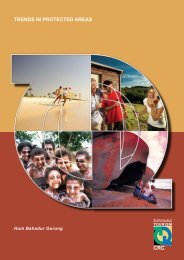icolls - Sustainable Tourism CRC
icolls - Sustainable Tourism CRC
icolls - Sustainable Tourism CRC
You also want an ePaper? Increase the reach of your titles
YUMPU automatically turns print PDFs into web optimized ePapers that Google loves.
ECOLOGY, THREATS AND MANAGEMENT OPTIONS FOR SMALL ESTUARIES AND ICOLLS<br />
Belongil Creek Tallows Creek<br />
101-150mm 5 2.33 (0.2) 12 10 4.1 (0.37) 14.3 (0.15)<br />
151-200mm - - - 1 4.74 (-) 16 (-)<br />
201-300mm 3 34.57 (4.85) 28.66 (0.88) 1 38.25 (-) 27 (-)<br />
301-400mm 2 41.09 (8.73) 33.25 (1.25) - - -<br />
400mm+ - - - 1 206.90 (-) 49 (-)<br />
S. ciliata 36 1.83 (0.16) 18.11 (0.28) 3 6.69 (0.26) 27.5 (1.5)<br />
Empty 9 - 25% 1.30 (0.12) 16.83 (0.12) 1 - 33.3% 1.68 (-) 16.5 (-)<br />
0-100mm - - - - - -<br />
101-150mm 4 0.93 (0.09) 13.75 (0.44) - - -<br />
151-200mm 22 1.95 (0.12) 17.14 (0.19) - - -<br />
201-300mm 1 4.86 (-) 21 (-) 2 6.69 (0.25) 27.5 (4.5)<br />
301-400mm - - - - - -<br />
400mm+ - - - - - -<br />
( ) = Standard Error<br />
The proportion of individuals with empty digestive tracts varied greatly between species (Table 8). For<br />
example, no individuals of M. cephalus were found to have an empty stomach, yet 47% of the P. fuscus<br />
individuals had empty stomachs. Within species the occurrence of empty stomachs was similar across both<br />
ICOLLs. Furthermore, the size classes collected for each species were similar between the two systems (Table<br />
8).<br />
Dietary Composition<br />
Gut contents analyses<br />
A. australis demonstrated the most diverse diet of the four teleost species examined (Table 9 and 10). In Belongil<br />
Creek, molluscs dominated the diet of A. australis with a mean volumetric contribution of 22.17% and an<br />
occurrence frequency of 66.6%. In contrast, the single individual collected from Tallows Creek contained no<br />
molluscs and relied more on crustaceans and polychaetes (Table 9 and 10). Algae was the most commonly<br />
ingested item in the diet of A. australis caught in Belongil Creek, being found in 83.33% of individuals and on<br />
average contributing 15% to the dietary volume.<br />
40<br />
Table 9: Dietary categories in the stomach contents of A. australis and P. fuscus in Belongil and Tallows<br />
Creeks<br />
Species Acanthopagrus australis Platycephalus fuscus<br />
ICOLL Belongil Creek Tallows Creek Belongil Creek Tallows Creek<br />
Number n=12 n=1 n=3 n=6<br />
Taxa %F %N %V %F %N %V %F %N %V %F %N %V<br />
Crustacea 8.3 16.4 5.8 100.0 90.0 45.0 - - - 66.6 63.6 62.5<br />
Decapoda 8.3 16.4 5.8 100.0 10.0 30.0 - - - 66.6 63.6 62.5<br />
Isopoda - - - 100.0 60.0 10.0 - - - - - -<br />
Amphipoda - - - 100.0 20.0 5.0 - - - - - -<br />
Polychaeta 33.3 65.6 10.0 100.0 10.0 45.0 - - - - - -<br />
Mollusca 66.6 80.3 22.1 - - - - - - - - -<br />
Bivalvia 58.3 70.5 20.5 - - - - - - - - -<br />
Gastropoda 25.0 9.8 1.6 - - - - - - - - -<br />
Teleosts 25.0 8.2 17.9 - - - 100.0 100.0 100.0 33.3 45.4 31.6<br />
FW Inverts * 8.3 1.6 2.9 - - - - - - - - -<br />
Sediment - - - - - - - - - - - -<br />
Algae 83.3 *** 15.0 - - - - - - - - -<br />
Plant Material 8.3 *** 7.0 - - - - - - - - -<br />
Other 66.6 *** 17.5 100.0 *** 10.0 - - - 33.3 *** 5.8<br />
%F = Frequency of occurrence, %N = percentage contribution by number, %V = volume of the dietary categories in the stomach contents; *<br />
FW Inverts were collapsed into one category due to the occurrence of specific taxa (Chironomids – S. ciliata, Coleopterans – A. australis and<br />
Hemipterans – M. cephalus); *** indiscrete dietary items inappropriate for numerical classification.











